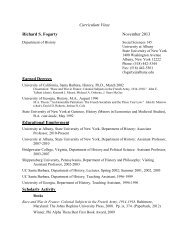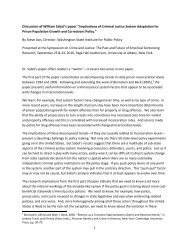Walking Corpses & Conscious Plants: Possibilist Ecologies in ...
Walking Corpses & Conscious Plants: Possibilist Ecologies in ...
Walking Corpses & Conscious Plants: Possibilist Ecologies in ...
You also want an ePaper? Increase the reach of your titles
YUMPU automatically turns print PDFs into web optimized ePapers that Google loves.
B<strong>in</strong>gham 31<br />
“graphic novel” was co<strong>in</strong>ed with Will Eisner's 1978 work, A Contract With God<br />
(Tabachnick 13). Yet even this orig<strong>in</strong> story is somewhat <strong>in</strong>accurate. Eisner admitted he<br />
had used the term dur<strong>in</strong>g a phone call with the president of Bantam Publish<strong>in</strong>g <strong>in</strong> New<br />
York when try<strong>in</strong>g to generate <strong>in</strong>terest about his new illustrated project that targeted adults<br />
rather than children; he knew the man was familiar with his earlier work on The Spirit,<br />
which ran from 1939 til 1952. Eisner had left his own lucrative firm <strong>in</strong> order to have the<br />
opportunity to market a narrative to an older audience through the Sunday papers.<br />
Apparently Eisner's reputation and the novelty of the phrase got him a face to face<br />
meet<strong>in</strong>g and the advice to seek out a smaller publisher:<br />
At the time, I thought I had <strong>in</strong>vented the term, but I discovered later that some guy<br />
thought about it a few years before I used the term. He had never used it<br />
successfully and had never <strong>in</strong>tended it the way I did, which was to develop what I<br />
believe was viable literature <strong>in</strong> this medium. (Eisner, 20 Feb. 2002)<br />
Eisner <strong>in</strong>correctly refers to a number of <strong>in</strong>dividuals <strong>in</strong> the preced<strong>in</strong>g statement. The first<br />
man Eisner wrongly discredits is Richard Kyle. Kyle first co<strong>in</strong>ed the term <strong>in</strong> 1964, “<strong>in</strong><br />
the pages of the Comic Amateur Press Alliance's newsletter, Capa-Alpha #2” (Kaplan<br />
14). Yet, when look<strong>in</strong>g at Kyle's words <strong>in</strong> “The future of 'comics,'” it's clear he<br />
absolutely meant what Eisner claims to have thought up:<br />
I cannot help but feel that "comic book" and "comic book strip" are not only<br />
<strong>in</strong>appropriate and antiquated terms with which to describe these genu<strong>in</strong>ely<br />
creative efforts and those of the even more fully realized productions which<br />
are bound to come, but are also terms which may easily prevent the early<br />
acceptance of the medium by the literary world. (Kyle, Wonderworld 2 pg.4)<br />
Eisner also claims success for an achievement that a number of others had already<br />
accomplished two years before A Contract With God. In 1976 multiple texts were<br />
published that claimed to be graphic novels directly on their title pages or dust-jackets.<br />
The front flap of Bloodstar, created by writer Robert E. Howard and artist Richard
















